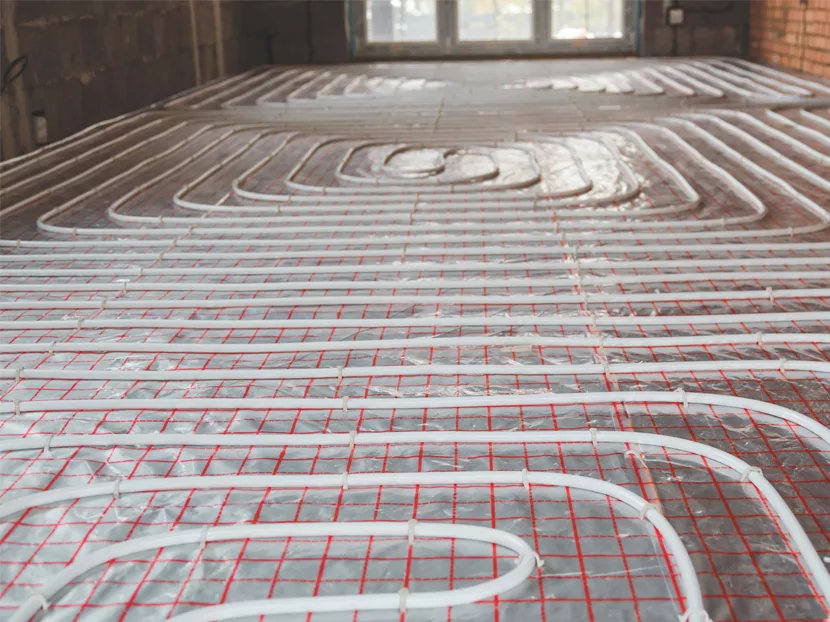I believe most people who have lived with a properly designed, installed and controlled radiant system agree that it is second to none. The quiet, clean, comfortable warmth provided by radiant surfaces makes the heart sing, as well as the feet warm. We underwent a renaissance for radiant in the 80s and 90s as plastic tubing became readily available and accepted. Polybutylene started the movement, and various versions of PE or PEX followed soon after. The ability to quickly “roll out” an installer-friendly, splice-free tubing loop made a huge difference in labor cost. Previous steel or copper tube systems required more skill and hours to install, in addition to the widely and ever-changing copper prices.
Around this “wonder tube,” manufacturers developed all the other components required to properly install the systems. Various control companies started up, boiler manufacturers developed low-temperature-friendly heat sources, a wider selection of circulators came into the market, and all was good.
Where radiant really flourished was in resort towns and in mountain areas, where air conditioning, or the lack of, was not a major concern in the residential markets specifically. Snowmelt and DHW options further promoted the attractiveness of “boiler-based” systems. In the resort area where we had our business, I’d guess 80 percent of the custom homes that we plumbed included some or total radiant systems. Realtors keyed into this upgrade and also helped drive the sales of radiantly heated homes.
Possibly hundreds of companies sprang up to support the radiant industry resurgence. The insulation industry got involved; floor-covering manufacturers addressed radiant-friendly products. Products developed to speed up and enhance the installation, from transfer fins to dry board subflooring options. Products specific to retrofitting radiant came along, and the electric cable and mat folks found a new niche for their wire.
This innovation continues to some degree, although not as strongly as the hay days. Tube manufacturers now offer roll-out mats to help lower labor hours. Boilers that can direct piped to low temperature are plentiful. Smart pump technology helps reduce after-market control costs so the industry continues to progress and evolve. In carefully designed applications, radiant cooling can be married with chilled beams of panel-type distribution. So, hydronics can completely condition a home or building.
At the same time, competitive products for heating, cooling and conditioning the space have also upped their game. The wide selection of mini-split systems may be one of the bigger competitors to radiant-based systems. Their installation is almost plug-and-play. More and more choices for emitters are available instead of just the hanging style. Plenty of sizes, and the ability to run multiple terminal units on one outdoor unit, broaden the acceptance. Heat pump versions allow for efficient heating, cooling and de-humidification. Prices on the equipment continue to drop as more and more players enter the market. In many countries, mini-split systems are the only, and sometimes best, option for millions of homes and businesses.
On the commercial side, the variable refrigerant flow (VRF) systems offer many of the same features and benefits of mini-splits. Unlimited zoning and control, easily retrofitted, provide a wide selection of products.
So, as a lifelong “wet head,” I wonder how hydronics stays in the game? I think we have always struggled to stay in front of the consumer with our “wet” message. Various marketing programs have been tried in the U.S. and Canada with mixed results. Our industry has never had the deep pockets to compete for customers’ attention via TV or Super Bowl ads, for example. In today’s fast-paced, instant gratification society, the message needs to be in front of prospective clients constantly, or they are easily led to the air-side. The HVAC world gets marketing and has plowed money and energy into prime-time spots and markets for decades. We have also had some limited success getting air-side contractors and associations to embrace and help spread our message. If they are busy and profitable doing HVAC, there is not a lot of incentive to learn a new skill and train and outfit crews to handle a small percentage of the market. Certainly, there are exceptions. Hurray for the mechanical contractors who have seen the radiant light and cross-trained and developed as the go-to broad-spectrum, HVAC and hydronic experts in their markets.
While these are not new or unique observations, how is our hydronic industry responding? Is the answer simply to grow this industry as our competition does? Is that even an option, or an affordable one? Or do we cling to the small percentage of the market we have, and hope for another plastic tube moment? Can a hydronics or hybrid trade association for our industry thrive as it did 20-30 years ago? Or is this a typical cycle, like a new restaurant that remains the buzz for only a short period of time and has to rebrand and put a new spin on the burger or sandwich?
Many of our industry’s roundtable discussions have labored over these questions and challenges. The early movers and shakers in our industry are steadily retiring. I challenge the youngsters to carry on and innovate our industry. Leverage your technology and communication skills. I’ve read that we have become an attention economy. How do we become clickable? How can we leverage that technology and means of communication? Kickstarter campaigns for new product ideas? Snappy social media that captures people developing, installing and enjoying hydronic systems? Any opinions or suggestions from our readers on how to keep the share we have, and grow our industry steadily, even at a slow pace, would work for me. We have brilliant, exceptional technology and installation skills, with products that provide superior comfort and energy efficiency. Let’s not lose any more ground. Let’s get growing!






